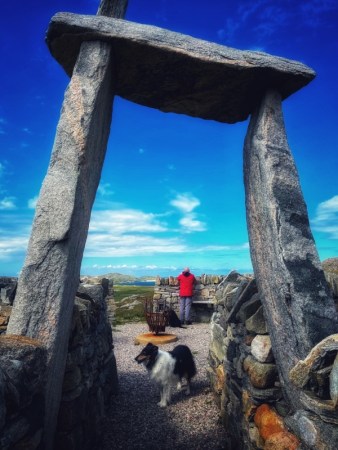
From the road that curls around the small hills on the way to the beach at Reef, in the Uig district of Bhaltos, it looks like a large cairn. The second time we drove by we saw the noticeboard and stopped to take a closer look.
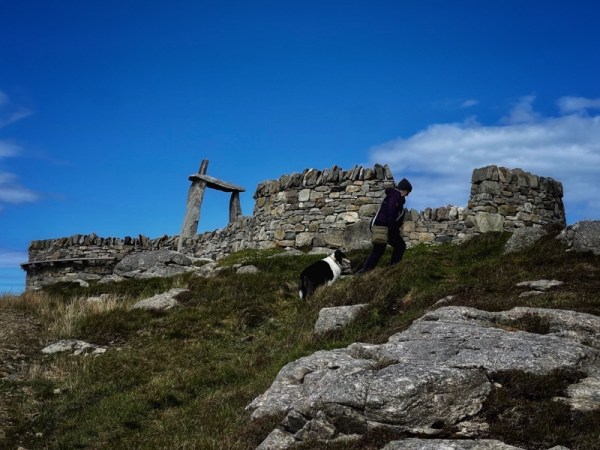
We climbed up the path to find a beautiful and touching monument on the hilltop, whose design was not visible from below. It was surrounded by views on all sides. Two things strike you, immediately: The isolation of the hill, itself; and the ancient connectedness of the people to this place – suggested by what looks like a giant tau-cross, but is based upon a stone construction method used in Neolithic times.
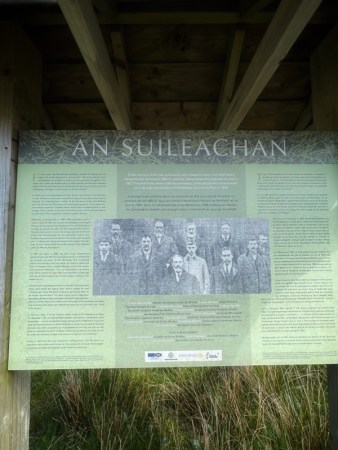
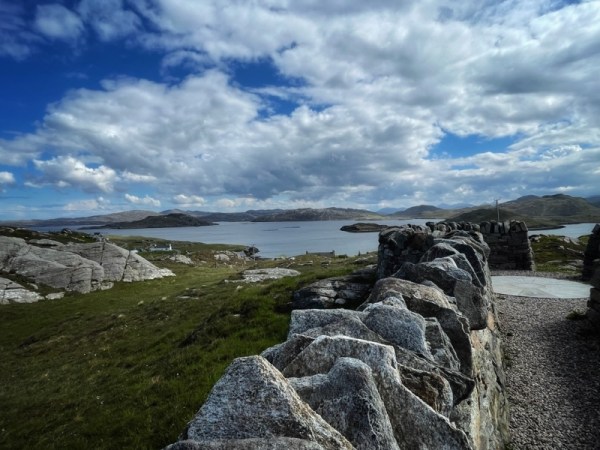
The curse of constant rain seemed finally behind us. We had become more relaxed and able to take in the beauty of the lochs, as in the view from the monument’s hill, above.
The Highland Clearances are well known as a dark period in Scotland’s history. They were the evictions of a significant number of tenants, many of them small-holding crofters, in the Scottish Highlands and Islands, mostly in two phases from 1750 to 1860.
The goal of the rich landlords was to replace humans with sheep, which were more profitable than the small rents charges to the farmers, whose only real assets were their culture, small-scale farming skills and love of the land. The crofters had lives, jobs, songs, families and folklore… and this was the only landscape they’d ever known.
A group of them refused to leave.
The notice board reads:
“To the memory of the men and women who resisted eviction from Reef before being forcibly removed in 1850-51…”
For three years, ending in 1850, 28 Reef families peaceably resisted all attempts by the estate of Sir James Matheson to remove them:
We had no arrears of rent and therefore we refused in a body to do this and stood out against it for three years, when Mr Scobie’s (the factor) term of office expired…”
The ‘factor’ was the man who enforced the land management and the will of the landowner. The following entry shows both the honesty and the naivety of the crofters:
We naturally expected justice from the next factor but, on the contrary, he took up at once the work his predecessor had begun and at last got us forcibly evicted”
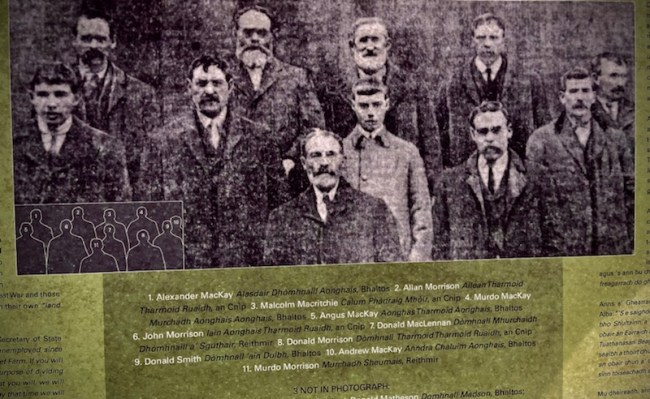
In 1850, they were dispossessed of their homes and removed from the land of their ancestors. Some were scattered throughout the Isle of Lewis and others sent as far as America.
The following year a further fourteen families were evicted from Bhaltos and Cnip. By the late 19th century, the remaining population of this peninsula, in the district known as “fourteen penny lands” were crowded together in two villages with no access to the land surrounding them, which had been deliberately added to large farms. Those crowded onto the single village included 31 squatter families, who owned nothing.
The resolute resistance continued and, in 1884, HMS Assistance, with a force of up to 100 Marines, arrived in Loch Roag to arrest eight Bhaltos men accused of placing animals on the offshore islands for grazing, not paying rents and ‘deforcing’ Sheriff’s Officers.
The men were sent for trial to Edinburgh and served time in prison. The following year ten men and seven women were fined for separate but similar actions. The women were charged with “mobbing and rioting and breach of the peace” and their fines, 5/- (shillings) each, were paid by the London branch of the Highland Land Law Reform Association, an influential organisation that was fighting for fairer land rights to reflect usage as well as ownership.
In 1891 and again in 1896, the Deer Forest Commission recommended that Reef should be scheduled for re-settlement…but no action was taken.
On 28th November 1913, 15 landless squatters from Bhaltos and nip drove the farmer’s stock fromReef to Timsgarry Farm. Alasdair MacKay, one of the raiders, told the parish Policeman:
“You can have plenty of prisoners now. We’ve waited too long. Reef was promised us long ago and now we have made up our minds to take it, whatever may happen to us.”
Interdicts were issued against them in February 1914 and when these were defied the raiders were cited to appear for trial in Edinburgh where the Court of Session sentenced them to six weeks imprisonment. This gave rise to much indignation throughout Scotland and a campaign led to them leaving prison after two weeks. Most of the raiders went off to fight in the Great War and those who survived came back more determined than ever to claim their own “land fit for heroes.”

In February 1920, 11 of the original raiders wrote to the Secretary of State for Scotland:
“We are demobilised soldiers and sailors unemployed since September …. we are compelled to begin Spring work on Reef Farm. If you will send the Commissioners of Small Holdings to us for the purpose of dividing the farm into crofts and putting us in possession as we trust you will, we will delay our operation to the 1st of March. If they are not here by that time we will be under the necessity of beginning work as a means to our livelihood”
Finally, in 1921, the land was restored to crofting tenure. The fact there is a population here today and a future for this community is due to the struggles undertaken by those who secured a just outcome at that time. As so often happens, the right outcome is fragile and often hangs by a thread.
The monument ‘An Suileachan’ was commissioned by the Bhaltos Community Trust and designed by artists Will Maclean and Marian Leven. It was constructed by island craftsmen – the stone circles by John Crawford, the iron brazier by John Macleod and the woodwork by John Angus Macleod.
The An Suileachan memorial is only seen in its full extent when you are on the high level. There is a central path that links two separate areas. At the central point of the path is what we named the ‘Tau gate’. You have to pass through this to see both ‘faces’ of the structure.
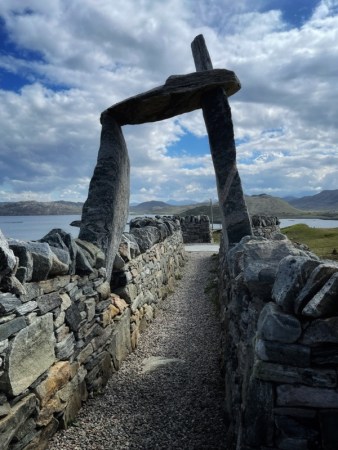
At the seaward end is a brazier, a beacon that gives off heat and the light of warning and preparedness.
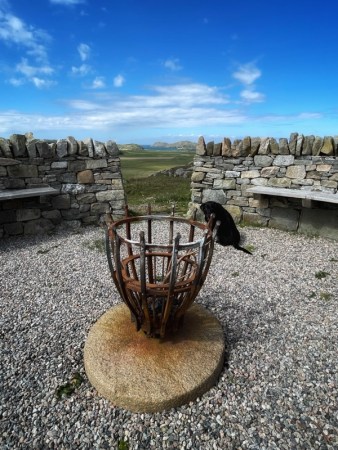
At the landward end is a circular stone plaque around which are carved the names of all those brave souls who were evicted from Reef by the second ‘Factor’. In one sense, the light and heat of the brazier-beacon highlights and protects them. They did not know that the great wrong done to them was to be corrected by friends and relatives after their deaths – to the great benefit of their community.

Their only weapon was the sense of truth and rightness they felt in their cause. A rightness much like the Biblical story of David and Goliath, where the monstrous apparent power of the giant is overcome by the simple stone of truth…
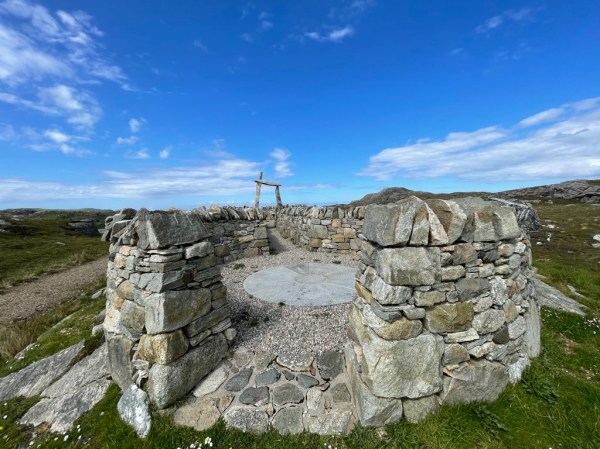
We can only aspire to such courage. You can tell in the quality of the monument how precious the memory of those brave souls is…

Part One: https://suningemini.blog/2022/05/24/a-poolewe-diary-1/
Part Two, https://suningemini.blog/2022/05/31/a-poolewe-diary-2/
Part Three, https://suningemini.blog/2022/06/06/a-poolewe-diary-3-the-loch-on-the-back-of-the-oats-box/
Part Four, https://suningemini.blog/2022/06/14/a-poolewe-diary-4-once-upon-a-time-in-the-far-north-west/
Part Five: https://suningemini.blog/2022/06/21/a-poolewe-diary-5-over-the-minch-to-lewis/
Continuation onto the Hebridean Island of Lewis:
A Hebridean Diary: Part One – Impressions of Lewis
A Hebridean Diary: Part Two – Long Road to Uig
A Hebridean Diary: Part Three – Of Coats and Kings
A Hebridean Diary: Part Four – The Drowned Lands
This is: A Hebridean Diary (5) When power is unchecked
©Stephen Tanham 2022
Stephen Tanham is a Director of the Silent Eye, a journey through the forest of personality to the dawn of Being.
http://www.thesilenteye.co.uk and http://www.suningemini.blog




























A fitting memorial. Some of these people were sent to Canada and helped to build a country strong and free.
LikeLiked by 2 people
That’s lovely to hear, Darlene. Thank you 😊
LikeLiked by 1 person
Many thanks for this interesting and touching story!
LikeLiked by 2 people
Thank you? Martina 😊
LikeLiked by 1 person
A moving account of a very dark period in our history, Steve. As a nation, we’ve made so many mistakes in allowing a corrupt power the upper hand. What a powerful tribute that sometimes a persistent decency can make a difference.
LikeLiked by 1 person
Perfectly expressed, Michael.
LikeLike
Pingback: A Hebridean Diary (6-end) Great Bernera – Sun in Gemini
Pingback: A Hebridean Diary (6 end) Great Bernera – The Silent Eye